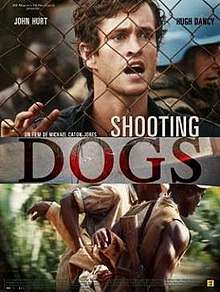Shooting Dogs
Shooting Dogs, released in the United States as Beyond the Gates, is a 2005 film, directed by Michael Caton-Jones and starring John Hurt, Hugh Dancy and Clare-Hope Ashitey. It is based on the experiences of BBC news producer David Belton, who worked in Rwanda during the Rwandan genocide. Belton is the film's co-writer and one of its producers.
| Shooting Dogs | |
|---|---|
 Promotional movie poster | |
| Directed by | Michael Caton-Jones |
| Produced by | David Belton Pippa Cross Jens Meurer |
| Starring | John Hurt Hugh Dancy Clare-Hope Ashitey |
| Music by | Dario Marianelli |
Production company | BBC Films Adirondack Pictures |
| Distributed by | IFC Films |
Release date |
|
Running time | 115 minutes |
| Country | United Kingdom Germany |
| Language | English French |
The setting of the film is the École Technique Officielle (ETO) in Kigali, Rwanda, in 1994, during the Rwandan genocide. Hurt plays a Catholic priest (loosely based on Vjekoslav Ćurić[1]) and Dancy an English teacher, both Europeans, who are caught up in the events of the genocide.
Unlike Hotel Rwanda, which was filmed in South Africa using South African actors, the film was shot in the original location of the scenes it portrays. Also, many survivors of the massacre were employed as part of the production crew and minor acting roles.
The film's title refers to the actions of UN soldiers in shooting at the stray dogs that scavenged the bodies of the dead. Since the UN soldiers were not allowed to shoot at the Hutu extremists who had caused the deaths in the first place, the shooting of dogs is symbolic of the madness of the situation that the film attempts to capture.
Cast (credited)
- John Hurt as Father Christopher
- Hugh Dancy as Joe Connor
- Dominique Horwitz as Capitaine Charles Delon
- Louis Mahoney as Sibomana
- Nicola Walker as Rachel
- Steve Toussaint as Roland
- David Gyasi as François
- Susan Nalwoga as Edda
- Victor Power as Julius
- Jack Pierce as Mark
- Musa Kasonka Jr. as Boniface
- Kizito Ssentamu Kayiira as Pierre
- Clare-Hope Ashitey as Marie
Crew
- Director – Michael Caton-Jones
- Writers – David Wolstencroft (screenplay), Richard Alwyn (story), David Belton (story)
- Original Music – Dario Marianelli
- Cinematography – Ivan Strasburg
- Editing – Christian Lonk
- Casting – Anja Dihrberg, Karen Lindsay-Stewart
- Production Design – Bertram Strauß
- Art Direction – Astrid Sieben
- Set Decoration – Dagmar Wessel
- Costume Design – Dinah Collin
Critical response
The review aggregator website Rotten Tomatoes reports an approval rating of 84% based on 63 reviews, with an average rating of 7.2/10. The website's critical consensus reads, "Complex, human characters and on-location shooting give Beyond the Gates palpable tension and urgency."[2] In The Guardian critic Rob Mackey wrote: "If you didn't know the story, you might expect the film to develop into a nice little culture-clash comedy… Shooting Dogs boasts a real location: the school in Kigali where a nightmare played itself out." In The New Statesman Victoria Segal wrote: "Shooting Dogs was shot in Kigali and the geography plays a significant role in generating stark fear: the oddly deserted streets, the bodies in the undergrowth, the humidity and dust. It is full of prickling moments of evil…"
Awards
1 win Heartland Film Festival 2006 Grand Prize for Dramatic Feature
See also
- Hotel Rwanda, a 2004 film dealing with the genocide that centers on the Hôtel des Mille Collines, a location also seen in Sometimes in April.
- Shake Hands with the Devil, a 2007 film based on the book of the same name recounting General Dallaire's harrowing personal journey during the 1994 Rwandan Genocide and how the United Nations failed to heed Dallaire's urgent pleas for further assistance to halt the massacre
- Rwandan genocide
References
- San Francisco Chronicle, Amid genocide in Rwanda, one man stands tall
- "Beyond the Gates (2005)". Rotten Tomatoes (Fandango). Retrieved March 24, 2018.
External links
- Shooting Dogs on IMDb
- Shooting Dogs at Rotten Tomatoes
- Does Shooting Dogs Lie?
- Acts of Genocide: Abrahamsson, Christian; Environment and Planning D 2008 26(4):736-639
Introduction to a series of academic articles discussing the film